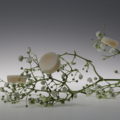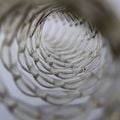From Light to Motion: Shaping surfaces with light

⤓
Researchers from the Multifunctional Materials Design group at Aalto University explored the use of photoactive materials to control surface topographies, specifically in generating photo-responsive wrinkle patterns. Azobenzene and its derivatives are employed to trigger photoisomerization reactions upon illumination, resulting in the conversion of electromagnetic energy into mechanical energy. In fact, supramolecular design is utilized to build polymer-azo complexes, allowing for easy tuning of the rate of pattern evolution at constant illumination intensity.
The study characterizes dynamic photoinduced wrinkle erasure enabled by photomechanical changes in supramolecular polymer-azo complexes via confocal microscopy. Furthermore, a MATLAB algorithm was developed to thoroughly analyze the video that captures the wrinkle erasure process. As a result, a combination of confocal microscopy and the mentioned MATLAB analysis enables a quantitative comparison of wrinkling erasure efficiency of different supramolecular materials and provides a facile way to optimize the system for specific applications.
This work provides insight into the conversion of molecular-level motion into larger scales and broadens other opportunities for tissue engineering and biological applications.
The findings were published in ChemPhysChem, Volume 24, Issue 13 (Yujiao Dong, Dr. Pedro E. S. Silva, Prof. Dr. Jaakko V. I. Timonen, Prof. Dr. Jaana Vapaavuori).
The news article was prepared by Bach Nguyen (MMD / Aalto University).

Related content:
Multifunctional Materials Design
Group led by Professor Jaana Vapaavuori

SUPER-WEAR project
Super-stretchable functionalized materials and fibers for third generation wearable technology

ModelCom project
Autonomously adapting and communicating modular textiles

- Published:
- Updated:
Read more news

Aalto in 2024: Love pictured in the brain, wooden crystals that make fashion shine, recovering minerals from wastewater and more
This year has been another feast of science and art at Aalto University
Pengxin Wang: The internship was an adventure filled with incredible research, unforgettable experiences, and lifelong friendships.
Pengxin Wang’s AScI internship advanced AI research, fostered global friendships, and inspired his journey toward trustworthy AI solutions.
Major grant from the Kone Foundation for modern architecture research - Laura Berger's project equates building loss with biodiversity loss
Aalto University postdoctoral researcher Laura Berger and her team have been awarded a 541 400 euro grant from the Kone Foundation to study the effects of building loss on society and the environment.